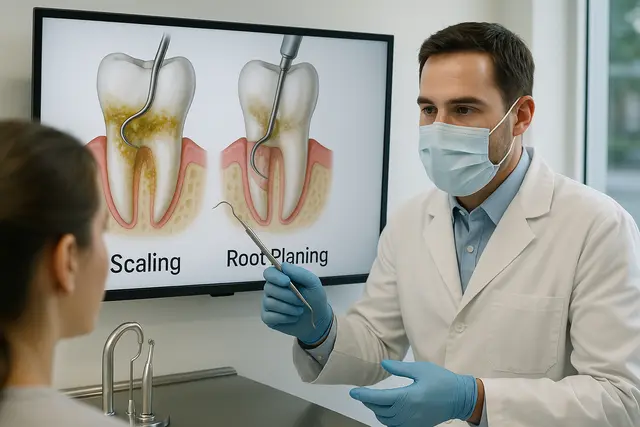General Dentistry
8 min read
Aug 24, 2025
Dental Terminology for Front Desk: Boost Accuracy and Professionalism
Working the front desk at a dental office means juggling patients, appointments, and insurance details, all while staying calm and professional. One of the most powerful tools in your toolkit? A solid understanding of dental terminology. Knowing the right terms not only boosts your confidence but also improves communication and accuracy across the entire practice.

Walking into a dental office can make even the bravest souls a little jittery. Between the hum of equipment and the strange names of dental procedures, patients already have a lot going on. Now imagine being at the front desk, the first smiling face people meet, and not knowing what a root canal really is or how to explain the difference between a crown and an implant.
Whether you're new or seasoned, mastering dental terminology for receptionists isn't just helpful, it's essential. You don’t have to become a dentist (whew), but getting fluent in the language of dental care means you can talk with confidence, book appointments correctly, answer common questions, and avoid billing blunders that can snowball fast.
Dental Terminology Explained Without the Headache
You don't need a degree in dental anatomy to understand dental terminology. What you do need is a firm grasp on the terms that come up every single day. When you can speak this language, you bridge the gap between patients, dental professionals, and insurance companies. You become the rockstar who keeps the whole dental office running like clockwork.
Some of the most common dental terms you'll run into include:
Cavity: A hole in the tooth caused by decay. Sometimes tiny, sometimes deep. Patients fear it, dentists fix it.
Root canal: A procedure to relieve dental pain and save the tooth when the pulp (soft tissue inside the root of a tooth) is infected.
Crown: A cap placed on a damaged tooth, or placed on a dental implant.
Implant: A metal post that replaces a tooth root, topped with a crown to make it look and function like a real tooth.
Abscess: A pocket of pus caused by infection, often painful and sometimes requiring urgent dental treatment.
Get comfortable with these and you’re already halfway there. Add in some x-rays that show teeth, some healthy gums and teeth, and you’re really starting to sound like a dental pro.
Dental Procedures Made Simple for Front Desk Heroes
When a patient calls asking if they need to "come in for a deep cleaning" or a "gum check," they’re referring to dental procedures. And knowing how to translate their concern into the correct appointment type is a skill worth gold (or at least a stress-free afternoon).
Common dental procedures and treatments you should recognize:
Prophylaxis (cleaning): Basic dental cleaning, covered under most basic dental benefit plans.
Scaling and root planing: Also called deep cleaning. It involves cleaning below the gumline to treat gum disease.
Root canal treatment: Already gave it a shoutout, but it bears repeating. This is a common way to relieve dental pain and infection.
Tooth extraction: Especially with impacted teeth (those stuck below the surface or positioned against another tooth).
Dental implant placement: A surgical procedure followed by fitting a crown.
Being able to understand dental procedures helps when explaining what dental services are recommended or what's reimbursed under the patient’s dental benefit plan. Plus, it prevents scheduling a cleaning when the patient actually needs a root canal. That’s a Monday nobody wants.
Understanding Dental Insurance Without the Tears
Let’s talk about dental insurance, aka the land of fine print. For a front desk receptionist, being able to translate dental insurance terms is like being fluent in another language. The goal? Help patients understand what they’re covered for and help the dental office get reimbursed without headaches.
Some terms to know:
Dental benefit: The amount or service covered by a plan for a specific dental procedure.
Dental benefit plan: Outlines exactly what dental services are covered, how often, and at what percentage.
Primary dental care provider: The main dentist listed under a patient’s dental benefit plan.
Administrator of a dental benefit: The company managing or paying claims.
Dental plan: Another way of referring to the insurance plan.
Dental coverage: General term for what the insurance plan pays for.
Clear communication here saves the day. Imagine a patient thinking their crown will be fully covered, only to learn the plan covers just 50%. If the receptionist plays it smart, they’ve explained this up front. No surprises, no complaints.
Basic Dental Vocabulary That Packs a Punch
Every dental receptionist should know the core terms that keep daily operations flowing. These aren't just fancy words; they help with accurate scheduling, correct insurance claims, and a smooth patient experience.
Soft tissue: Gums, cheeks, tongue, basically everything in the mouth that isn’t teeth or bone.
Tooth numbers: Dentists often refer to teeth by number. For example, "#3" might be a molar in the upper right.
Lower jaw: The mandible. Often referenced in x-rays or procedures.
Molar: The big teeth in the back, perfect for chewing.
Front teeth: The incisors and canines, these matter a lot for aesthetics and speech.
Learning these terms is like learning the streets of your city. You don’t need every single alley memorized, but the main roads? Absolutely.
Dental Anatomy for Receptionists Who Want to Shine
You don’t need to rattle off every nerve and ligament, but understanding dental anatomy builds your confidence when explaining procedures or answering patient questions.
Key parts to recognize:
Root of a tooth: The part that anchors the tooth in the jawbone. When infected, it often leads to a root canal.
Gum: Supports the teeth and protects the roots. Healthy gums are essential for long-term dental health.
Dental arches: The curved rows of teeth in the upper and lower jaws.
Throw in a few terminology flashcards to practice with your team, and you'll be the dental anatomy MVP in no time.
Dental Insurance Terms You Actually Need to Know
More than just benefit plans, dental insurance terms pop up in conversations, billing, and paperwork all day long. Knowing these keeps everything moving smoothly.
Here’s a quick list of common terms:
Claim: Request sent to the insurance for payment.
Deductible: Amount the patient pays before insurance kicks in.
Co-pay: The portion the patient owes after insurance.
Exclusions: Services not covered under the dental benefit plan.
Frequency limitations: Limits on how often services are reimbursed under the patient’s dental plan (like two cleanings per year).
Get cozy with these. They make or break your billing game.
Why a Rockstar Receptionist Knows Dental Terminology
The receptionist plays a huge role in the success of a dental practice. You're not just answering phones or handing out forms. You're the glue. You're the calm voice. You’re the translator between dental professionals, insurance companies, and sometimes nervous patients who just need someone to make things simple.
Being fluent in dental terminology for receptionists helps you:
Explain procedures in patient-friendly terms
Avoid costly billing errors
Navigate different dental benefit plans with ease
Make the entire dental office look organized and professional
Bonus? Patients trust you more. That’s good for business and good for your job satisfaction.
Dental Terms Every Receptionist Should Master
Here’s your unofficial, totally non-boring list of common dental terms to keep handy:
Anterior: Front of the mouth
Posterior: Back of the mouth
Bridge: A fixed appliance that replaces missing teeth
Crown: Cap that covers a damaged tooth
Implant: Artificial root placed in the jaw to hold a replacement tooth
Gingivitis: Early gum disease
Periodontitis: Advanced gum disease that affects the bone
X-ray: Images that show what’s happening under the surface
Impacted teeth: Teeth that are trapped in the gums or jaw
Abscess: Infection that causes pain and swelling
This list of common dental terms could easily become a cheat sheet for training or daily use. Stick it next to your monitor.
Billing Without Panic
Billing can feel like a maze, especially with multiple types of dental benefit plans and dental insurance terms floating around. But once you understand how different dental services are provided under the terms of a patient's dental benefit, things fall into place.
Hot tip: Always verify the patient’s dental insurance before the appointment. It saves last-minute scrambles and surprises at checkout.
Also, note that:
Procedures must match what the benefit plan allows
Some treatments (like root canal or implant) may need pre-authorization
Dental replacement items (like dentures or crowns) may only be covered every X years
Make sure your billing codes align with what’s allowed. Accurate billing isn’t just good for the practice, it’s a sanity-saver.
Dental Terminology for Receptionists That Impresses Everyone
Once you're solid on terminology, you're no longer just the front desk person. You're a dental administrative genius. You help explain procedures, provide accurate estimates, communicate with insurance reps, and support patients through confusing paperwork.
That’s why brushing up on dental terminology for receptionists should be part of every training manual and new hire onboarding.
You’ll feel more confident when someone asks if scaling and root planing is a cleaning or treatment (trick question: it’s both). You’ll know exactly what to say when a patient wants to know if their dental plan covers x-rays. And when the dentist throws around terms like "soft tissue impaction," you won’t break a sweat.
Common Dental Terms and Their Real-World Importance
If you work in the front of the dental office, you’re probably the one who:
Answers the phone when a patient asks what the heck a "deep cleaning" is
Submits insurance claims
Translates what the dental specialist said into something a patient understands
Explains why their basic dental benefit only covers part of that crown
Knowing common dental terms isn’t about sounding smart. It’s about connecting with people and doing your job better. You support the teeth (and the whole team, honestly).
Types of Dental Professionals and What They Do
It helps to know the dental specialties and who does what. It also makes referrals easier.
General Dentist: The primary dental care provider.
Periodontist: Treats gum disease and performs procedures like root planing.
Endodontist: Specializes in root canal treatment.
Oral Surgeon: Handles extractions, implants, and impacted teeth.
Orthodontist: Straightens teeth.
Prosthodontist: Focuses on dental replacement like dentures or bridges.
Different dental issues require different dental specialists. If you can recognize the types of dental providers and specialties, you’ll book appointments more accurately and support both the dentist and the patient better.
Why Is Dental Terminology Important for Front Desk Staff?
Dental terminology is essential for receptionists because it ensures accurate scheduling, billing, and communication with both patients and insurance providers. When staff understand terms like crown, implant, or root canal, they can confidently explain procedures, reduce confusion, and prevent costly errors. This fluency also builds patient trust and reinforces professionalism within the dental practice.
What Common Dental Terms Should Receptionists Know?
Receptionists should be familiar with core vocabulary used daily in dental practices. Examples include cavity (tooth decay), crown (a cap for damaged teeth or implants), implant (an artificial tooth root), abscess (infection with pus), and prophylaxis (cleaning). Knowing these terms helps staff translate dentist instructions into clear explanations for patients and ensures procedures are scheduled correctly.
How Can Receptionists Better Understand Dental Insurance Terms?
Receptionists play a key role in guiding patients through insurance details, so understanding insurance terminology is critical. Terms like deductible, co-pay, exclusions, and frequency limitations determine how much a patient pays and what services are covered. By explaining coverage clearly, receptionists prevent misunderstandings, for instance, clarifying that a crown may only be 50% covered instead of fully reimbursed.
What Types of Dental Professionals Should Receptionists Recognize?
Understanding dental specialties helps receptionists book patients with the right provider. A general dentist handles routine care, while specialists include periodontists (gum disease), endodontists (root canals), orthodontists (braces), prosthodontists (dentures/bridges), and oral surgeons (extractions and implants). Recognizing these roles allows front desk staff to direct patients efficiently and support referrals with accuracy.
Read Next
Related Posts

General Dentistry
How to Stop Nerve Pain in Tooth: Fast Relief That Works
Tooth nerve pain can be one of the most intense and disruptive types of discomfort. It often strikes without warning and makes everyday activities like eating, drinking, or even talking feel unbearable. Understanding what causes this pain and how to manage it effectively is key to getting fast relief.
4 min read
Sep 15, 2025

General Dentistry
Can a Sinus Infection Make Your Jaw Hurt? Understanding the Connection
Jaw pain can be unsettling, especially when it seems to appear out of nowhere alongside a stuffy nose or headache. Many people are surprised to learn that sinus infections can cause discomfort that feels like it’s coming from the jaw. Understanding the connection between your sinuses and jaw pain is key to getting the right treatment.
5 min read
Sep 15, 2025

General Dentistry
What Is SRP in Dentistry? A Complete Guide to Scaling and Root Planing
When it comes to dental health, most people think regular cleanings are enough to keep their smile safe. But sometimes, what’s happening below the gumline needs more attention. Scaling and root planing (SRP) is a treatment designed to address gum disease at its source, protecting both your gums and teeth from long-term damage.
5 min read
Sep 10, 2025
Don’t have time to research every dentist around you?
See why 30k+ patients trusted us